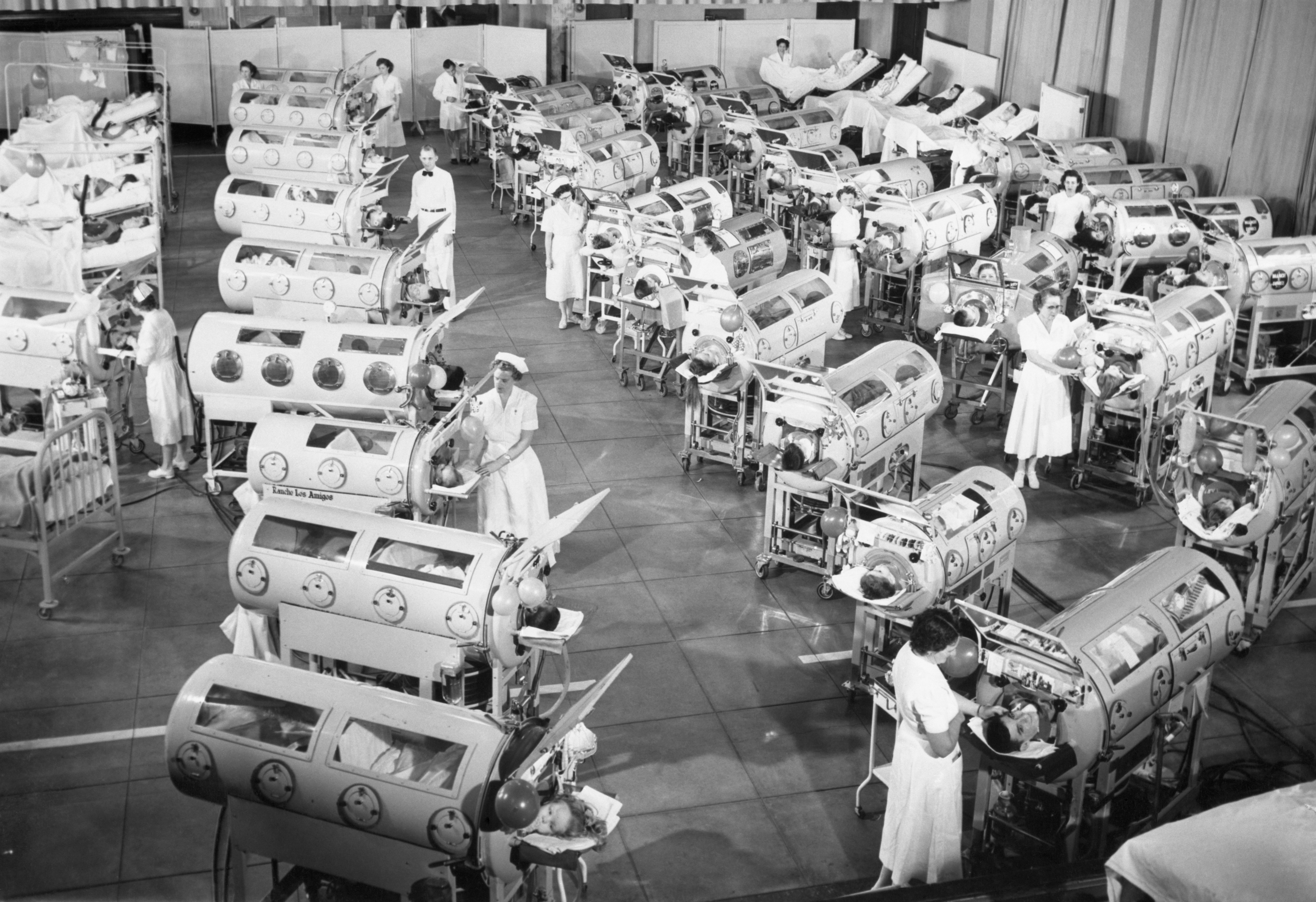How Did a ‘Coffin on Legs’ Become the Lifeline for Polio Victims?
The iron lung was a large metal cabinet respirator that used External Negative Pressure Ventilation to save thousands of polio victims whose chest muscles were paralyzed. First used at Boston Children’s Hospital in 1928 to save an eight-year-old girl, by 1939 around 1,000 iron lungs operated in the USA, providing the rhythmic “whoosh” sound that meant life for patients who couldn’t breathe on their own.
Dr. Kumar’s Take
The Science Museum’s analysis reveals how desperate innovation created life-saving technology. The iron lung looked terrifying - patients described being sealed into something resembling a coffin - but it was the difference between life and death for paralytic polio victims. What’s remarkable is how quickly engineers improved the design, from Drinker’s original to Emerson’s patient-accessible version to Both’s cheap plywood model that could be built in an hour. This technology sustained life until muscles recovered or, tragically, for a lifetime in severe cases.
What the Research Shows
According to the Science Museum, the iron lung emerged from the desperate need to address polio’s most deadly complication. When polio paralyzed chest muscles, patients couldn’t breathe unaided and faced death. The solution came from Harvard University researchers who developed this life-support technology that became synonymous with polio treatment.
The first iron lung saved an eight-year-old girl at Boston Children’s Hospital in 1928. As polio epidemics intensified, reaching their U.S. peak in 1952 with 57,628 cases, iron lungs became essential equipment in polio wards across the country.
Historical Context
The iron lung’s development reflects both medical innovation and legal battles over life-saving technology. Philip Drinker and Louis Agassiz Shaw invented the first version at Harvard School of Public Health - a huge metal box with bellows that enclosed the patient’s entire body except the head, sealed with a tight rubber collar around the neck.
In 1931, John Haven Emerson improved the design by making the bed slide in and out of the cabinet and adding portholes for patient access without losing air pressure. This led to a patent dispute when Drinker and Harvard sued Emerson for infringement.
The court case had profound implications for medical technology. Emerson’s lawyers demonstrated that all technologies used by Drinker already existed and couldn’t be patented. Emerson won, all patents were declared invalid, and the judge agreed that “a technology that saved lives should be shared by everyone.”
Study Snapshot
Iron Lung Development Timeline:
- 1928: First use at Boston Children’s Hospital saves eight-year-old girl
- 1931: Emerson improves design with sliding bed and portholes
- 1937: Both Respirator developed in Australia using plywood for cheaper production
- 1939: Approximately 1,000 iron lungs in use across the USA
- 1950s: Gradual replacement with modern ventilators after polio vaccines
Key Innovations:
- Drinker Model: Original design with bellows system
- Emerson Model: Added patient accessibility features
- Both Respirator: Plywood construction, could be built in one hour
- Smith-Clarke Models: Later “alligator” style designs requiring less space
How This Works (Biological Rationale)
The iron lung operated through External Negative Pressure Ventilation (ENPV). The bellows sucked air out of the sealed box containing the patient’s body. As air pressure in the box fell, the patient’s lungs automatically expanded, drawing fresh air into the diaphragm through the exposed head.
When the bellows allowed air back into the box, air pressure rose and the patient’s lungs deflated passively, pushing air out. This created the characteristic rhythmic “whoosh” sound that became the reassuring indicator of patient breathing.
Unlike modern positive-pressure ventilators that push air into the lungs through tubes, the iron lung worked by manipulating external pressure to make the chest wall move naturally.
Why This Matters for Modern Medicine
The Science Museum’s documentation reveals several crucial principles for medical technology development:
Open Innovation: The court ruling that life-saving technologies should be shared by everyone established important precedent for medical device accessibility.
Rapid Iteration: Multiple inventors quickly improved the basic design - Emerson’s accessibility features, Both’s cost-effective materials, and various space-saving models showed how urgent need drives innovation.
Patient Experience: The museum’s accounts of patient life in iron lungs - the boredom, fear, and gradual rehabilitation process - highlight the importance of considering quality of life alongside life preservation.
Technology Evolution: The transition from iron lungs to modern ventilators demonstrates how medical technology advances while maintaining core life-support functions.
Safety, Limits, and Caveats
Life in an iron lung presented significant challenges documented by the Science Museum:
Patient Limitations: All care had to be provided through portholes when possible. Tasks like physical therapy required brief periods outside the machine when patients could breathe independently - a terrifying experience patients described as straining “every fibre for a breath of air.”
Psychological Impact: Patients faced extreme boredom and isolation. Mirrors were attached above heads so patients could see their surroundings, and books were suspended for reading if someone turned pages.
Recovery Process: Learning to breathe again was “difficult and frightening.” Patients gradually built chest muscle strength by extending time outside the cabinet, with some eventually using rocking beds that used gravity to assist breathing.
Duration Variability: Most patients used iron lungs for weeks or months, but those with permanently paralyzed chest muscles faced lifetime confinement.
Practical Takeaways
- Understand the innovation: Iron lungs used negative pressure to make paralyzed chests move naturally
- Appreciate rapid development: From 1928 invention to 1,000 machines by 1939 shows crisis-driven innovation
- Learn from legal precedent: Court ruling established that life-saving technologies should be shared freely
- Recognize patient experience: Technology must consider quality of life alongside life preservation
- Value accessibility improvements: Emerson’s portholes and sliding beds showed how design iteration improves patient care
- Support modern alternatives: Today’s positive-pressure ventilators provide better patient access and monitoring
Related Studies and Research
- What Is Poliomyelitis? The Virus That Once Terrorized America
- Paul Alexander: The Man Who Lived 72 Years in an Iron Lung
- 1952: The Year Polio Struck 57,879 Americans - A Record-Breaking Epidemic
- The March of Dimes: How FDR’s Campaign Funded the Polio Vaccine
- Episode 28: Iron Lungs, Fear, and a Miracle: How We Stopped Polio
FAQs
How did the iron lung actually help patients breathe?
The iron lung used negative pressure ventilation - bellows sucked air out of the sealed chamber, causing the patient’s chest to expand and draw air into their lungs naturally, then released pressure to allow exhalation.
Why did the patent dispute over iron lungs matter?
The court ruled that life-saving technologies should be shared by everyone, establishing important precedent that medical devices essential for survival shouldn’t be restricted by patents.
What was daily life like for iron lung patients?
Patients faced significant challenges including boredom, isolation, and fear. All care was provided through portholes, mirrors helped them see surroundings, and books were suspended for reading with assistance.
How long did patients typically stay in iron lungs?
Most patients used iron lungs for weeks or months while chest muscles recovered, but those with permanent paralysis faced lifetime dependence on the machines.
What replaced iron lungs after polio vaccines?
Modern positive-pressure ventilators gradually replaced iron lungs. These push air directly into the lungs through tubes, allowing full patient access and better monitoring of vital signs.
Bottom Line
The iron lung transformed from a terrifying “coffin on legs” into a lifeline that sustained thousands of polio victims when their chest muscles failed. Through rapid innovation from Drinker’s 1928 invention to 1,000 machines operating by 1939, this negative-pressure technology bridged the gap between paralysis and recovery - or provided lifetime support when recovery wasn’t possible - until vaccines eliminated the need for these remarkable machines.


